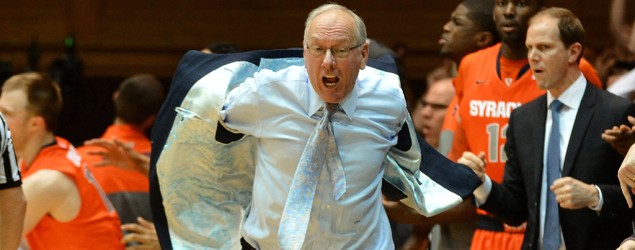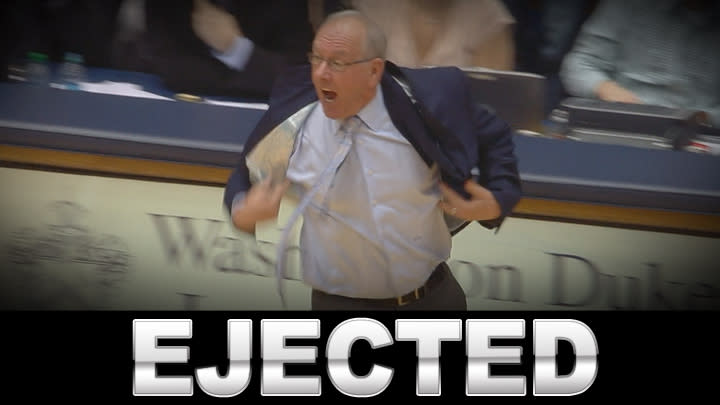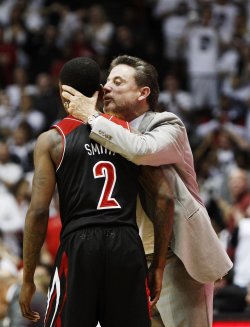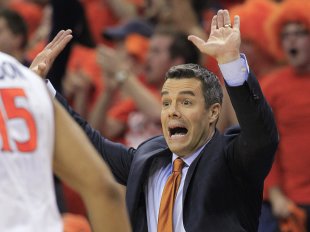
Forde Minutes: Blame the Jim Boeheims, not the refs
Forty names, games, teams and minutiae making news in college basketball (Jim Boeheim-as-Michael Jackson photo comedy sold separately):
STOP THE OPEN SEASON ON OFFICIALS
When Jimmy met Tony (1) on Saturday in Cameron Indoor Stadium, it was a seminal moment in the long and florid history of college basketball coaching tantrums. The Minutes ranks Boeheim's explosion at Tony Greene alongside the 2002 head-slapper from Indiana's Mike Davis against Kentucky as the most memorable freakouts of the 21st century.
But among the many problems with Boeheim's completely unapologetic eruption is this: it promotes the mindset that the scapegoating of officials is acceptable.
If you blame the refs when your team loses, you are a loser. That eternal truth needs to be repeated every so often – especially at this pressurized time of year, where difficult calls are scrutinized with a microscopic specificity and a level of outrage that is unhealthy for everyone involved. Twitter, message boards and call-in shows are veritable forest fires of ref-bashing both during and after games.
The acceptance of an element of human error in officiating seems to be dwindling, which is not necessarily a good thing. Replay review has generally been a positive for all sports – but there will always be judgment calls, and some of them will be wrong, and that's just the way the ball bounces. Refs should be held accountable for their mistakes, and that includes public explanations of controversial calls, but there is a difference between criticism and vilification.
Life is not fair, and an acceptance of that reality is helpful in all walks of life – sports very much included. Refs are going to miss some block-charge calls, because they're the hardest calls to make. And no number of slow-motion replays or frame-by-frame pictures will change that the day after. These are not murder cases where new DNA evidence can be introduced to change the outcome of a trial.
"It's such a different business than even five years ago," said John Adams (2), the NCAA's national coordinator of officials, to The Minutes on Monday. "The games don't ever end."
The concern here is this: that the level of condemnation and second-guessing will dissuade the next generation of competent officials from taking up the profession. Adams agrees – though not for exactly the same reason.
"I worry about the very beginning levels," Adams said. "We wash out lots of young referees in the first couple years of working high school games and summer leagues because of the abuse they take from coaches and parents.
"If you can get past that and get into college, it's usually OK. I have rarely had anybody complain to me about the crap they take from coaches at the college level."
Still, the crap seems to come at refs in much larger doses from college coaches than NBA coaches. The Minutes has heard multiple college coaches with NBA experience say college officials tolerate far more flak than their counterparts at the highest level.
It doesn't seem coincidental that the coach The Minutes has seen engage in the least ref-baiting all season is the coach with the most NBA experience: Larry Brown of SMU.
Art Hyland, rules secretary for the NCAA and former coordinator of officials for the Big East, said he believes coaches are less vitriolic toward refs than in the 1980s. (The simple subtraction of Bob Knight and Jim Calhoun alone may account for that.) But Hyland cited guidelines for coaching decorum that were put in the NCAA rule book two years ago, and upon examination there is plenty of unchecked behavior and uncalled technical fouls out there on a nightly basis. Among the guidelines going notably unenforced:
• Prolonged, negative responses to a call/no-call, which is disrespectful/unprofessional and includes, but is not limited to: thrashing the arms in disgust, dramatizing contact by re-enacting the play, or running or jumping in disbelief over a call/no-call.
• A negative response to a call/no-call including, but not limited to, approaching/charging an official in a hostile, aggressive or otherwise threatening manner, emphatically removing one's coat in response to a call/no-call or throwing equipment or clothing on the floor.
• Continual criticism during a game regarding the same incident after warning by an official.
Profanity is also a no-no. Which is ha-ha funny. Refs are taking a lot more of that than you may think.
And then there is the coaching box, which gets less respect than the speed limit. Some coaches have been wandering as far as midcourt this year. John Calipari went onto the court at LSU to shove guard Andrew Harrison into motion on offense, with no resulting whistle. On Monday night against Syracuse, Mark Turgeon skittered halfway to Baltimore in the final seconds without an official ringing him up.
Adams acknowledged enforcement of the guidelines is "uneven. There are some referees and conferences that do a notably better job."
The refs in general need to curtail their conversations with coaches, too. There is way too much discussion going on, creating the perception that the zebras can be lobbied into or out of calls.
Before the NCAA tournament, Adams said he tells the 100 officials selected to keep in-game dialog brief.
"If you get a pertinent question and it deserves an answer, give a polite, concise answer and get on with the game," Adams said.
And if the game doesn't turn out the way you like? Don't blame the refs.
BURNING QUESTIONS, BY CONFERENCE
Amid the February stretch run, The Minutes tackles some key issues in each of America's top eight leagues.
AMERICAN ATHLETIC CONFERENCE
Who is the Player of the Year (3)? It's a compelling three-guard race between Cincinnati's Sean Kilpatrick, Louisville's Russ Smith and Connecticut's Shabazz Napier. Kilpatrick is the most indispensable offensively, scoring 29 percent of the Bearcats' points, making 34 percent of their free throws and 48 percent of their 3-pointers. Analytics guru Ken Pomeroy gives the edge to Smith, whose scoring average is slightly down from last year (18.7 to 17.5) but assist average is considerably up (2.9 to 4.5) and so are his field-goal percentages (41 to 46 overall, 33 to 37 from 3-point range). Napier is the most well-rounded, leading the Huskies in scoring (17.8), rebounding (5.9), assists (5.4) and steals (1.9). (The fact that a 6-foot-1 guard leads UConn in rebounding is an indictment of the team's big men.) Solution: to the victor belong the spoils. Whichever player's team wins the league should be Player of the Year, which right now looks like a two-man race between Kilpatrick and Smith.
Who plays in the Quarterfinal of Death (4)? There figures to be three walkover games in the AAC tournament quarters, and one donnybrook between whoever winds up in fourth and fifth. This is the league with the greatest disparity between top half and bottom half, which means the top three seeds will draw from the dregs of the conference. But the Nos. 4 and 5 seeds will meet for the chance to play the regular-season champion in the semifinals. Right now the two teams ticketed for those spots are Memphis (the tourney host) and UConn, but Southern Methodist is only half a game ahead of the Tigers. The battle for third could come down to the last regular-season games, when the Mustangs visit Memphis and the Huskies visit Louisville.
Of all the good work done by Larry Brown (5), is this the best? For a guy who has been a head coach since 1972 at 13 different places, that's almost impossible to answer. But in terms of elevating a program/organization, this has to rank right up there with reviving the San Antonio Spurs in the late 1980s and getting the horrendous L.A. Clippers to the playoffs in 1992 and '93. Despite taking over a program with no tradition and no momentum, the Mustangs are ticketed for their first NCAA tournament berth since 1993. Similar to Nick Saban at Alabama, it took Brown one season to get acclimated, and then it was time to start piling up victories in season No. 2. There have been 22 of them so far this year, SMU's most since 1988 – which happens to be the year Brown won the national title at Kansas.
ATLANTIC-10
How good is Saint Louis (6)? The record is ridiculous: 25-2 overall, 12-0 in a tougher-than-expected league. Point guard Jordair Jett is a Minutes favorite, an alpha male point guard who should be the league Player of the Year. And the Billikens will guard till the last dog dies. But there is reason to wonder how well this team will translate to playing the kind of competition they will face in the NCAAs. If you use the Pomeroy Ratings as a yardstick, Saint Louis is only 2-2 against the top 50, and both those victories were at home. There are road games against No. 23 VCU and No. 44 Massachusetts still to come; maybe those will help show this team is worth its top-10 ranking. Hard to forget that the offensively laborious Billikens flopped last year in the NCAA tourney as a four seed, being routed by No. 12 Oregon in the round of 32.
Who else gets NCAA bids (7)? UMass, VCU and George Washington appear to be solidly in the field at the moment, although the Rams and Colonials have staggered lately and can't afford an all-out tailspin. Then it gets interesting. St. Joseph's (9-3) has risen to second in the league standings, and Richmond (8-4) and Dayton (7-5) both are loitering around the bubble as well. This league tournament could have as much bubble intrigue as any. When the smoke clears on Selection Sunday, expect to see five A-10 teams dancing.
How problematic is the unbalanced schedule (8)? Here's what makes it hard to confidently rank the A-10 teams – there are 13 of them playing a 16-game league slate, which means you get some wide variance in strength of schedule. According to Pomeroy, no team in the top eight of the A-10 standings has played a top-four schedule – and league-leading Saint Louis has played the easiest slate to date. That's one more reason why the neutral-floor league tournament will be vital to figuring out how this conference truly stacks up.
ATLANTIC COAST CONFERENCE
Is Syracuse (9) fading again? Boeheim was at his most snide when asked Saturday night about the Orange's two-game losing streak. "That's awful, isn't it? I just don't know what to do. I'll probably cry all the way home. I don't think we'll probably play anymore. I think we'll just give up." His team took a tiny bit of steam out of the Syracuse Backslide Theory Monday at Maryland, barely holding on against a team that badly needed the win. But let's revive this stat: through the first 18 games of the year over the last six years, Syracuse is 104-4. For the remainder of the regular season during that time, it is 61-24. Certainly, that factors in the 'Cuse's traditional home-laden non-conference schedule, but even taking that into consideration, this is a program that has not finished as well as it has started in recent years. We'll see what happens in the final three games: at Virginia, home against Georgia Tech and at bubblicious Florida State.
Is Virginia (10) good or great? Speaking of unbalanced schedules: Pomeroy says the Cavaliers have had the easiest run to date of anyone in the 15-team ACC. They've only played Duke and North Carolina once each, and have yet to meet Syracuse. So there is a reason for being 14-1 in the league beyond just playing great defense. Hats off to Tony Bennett for a fine coaching job, but The Minutes isn't ready to declare a team that lost by 35 to Tennessee or scored 38 at home against Wisconsin to be Final Four material.
How legit is the North Carolina (11) resurgence? Pretty legit. The Tar Heels have plenty of size and depth, and with Leslie McDonald coming on they are shoring up their perimeter shooting weakness. But the best thing about this team is its zeal for defense, which hasn't always been the case with Roy Williams' teams. (This is just the third of his 11 North Carolina teams that Pomeroy rates more highly defensively than offensively.) Even with two road games this week, expect the Heels to take a 12-game winning streak into Cameron Indoor to end the regular season. UNC will be a trendy Final Four pick by the times the brackets get printed.
BIG 12
What to make of the twin towers of underachievement (12)? That would be Oklahoma State and Baylor. The Cowboys were picked as league preseason co-favorites alongside Kansas, and the Bears were picked third in the conference. Now, they are scrambling in an effort to avoid playing on the first day of the Big 12 tournament while the top six teams have a bye. Baylor (6-8) is currently in seventh (which means it would play TCU in the first round) and Oklahoma State (5-9) currently is tied for eighth (and would play Texas Tech in the first round). Despite some dismal basketball for long stretches, both teams still have a chance for at-large NCAA berths. The Bears have won four straight to give themselves a chance, and the Cowboys have won two straight after getting Marcus Smart back from suspension. Smart's absence during an 0-3 stretch will be taken into account by the selection committee. Both teams have the talent to not only make the tourney, but make a run in the tourney – if they've put their dysfunctional days behind them.
Is Andrew Wiggins (13) ready to blow up? The consensus No. 1 recruit in the class of 2013 has fit in – rather than stand out – for Kansas so far this season. But that is a tribute to Bill Self's system and the depth of surrounding talent more than a knock on Wiggins – who, it must be said, is still the Jayhawks' leading scorer at 16.4 points per game. This is more a hunch than cold science, but The Minutes expects Wiggins to elevate his level of play heading into March – and especially the NCAA tourney, when Kansas is freed from the double-round-robin familiarity of the very competitive Big 12. He may not be ready to live up to the Best Prospect Since LeBron hype yet (or ever), but he may yet leave an indelible mark on college hoops.
Is there a second Final Four contender (14) in the league? After Kansas, the pickings are slim. Plenty of good teams but only one that appears to have the chance to be elite. The Minutes loves Fred Hoiberg and the job he's done at Iowa State, but the Cyclones don't defend like a Final Four team – and it's hard to forget that no-show at West Virginia in which Iowa State surrendered 102 points. Oklahoma is well-coached but not lavishly talented. Texas has come back to Earth. Kansas State is a home-court phenomenon. And as mentioned above, Oklahoma State and Baylor have been too psycho to trust. The Big 12 has had just one program advance to the Final Four since 2004, and that's the Jayhawks. That doesn't appear likely to change in 2014.





No comments:
Post a Comment